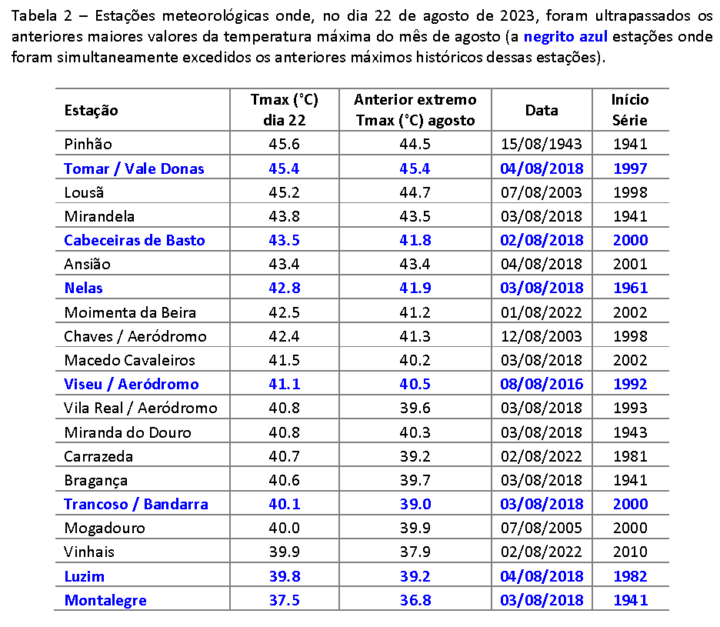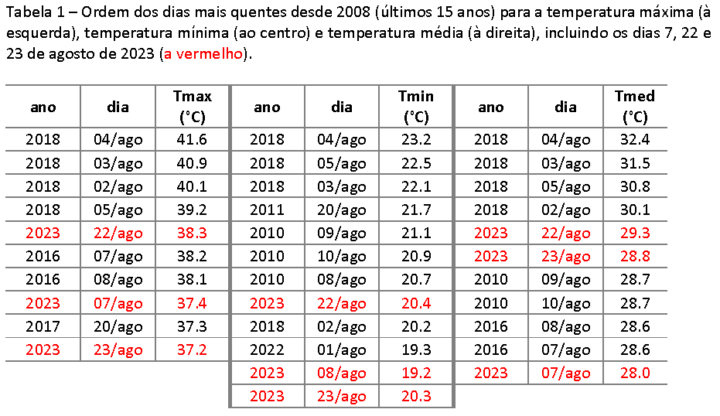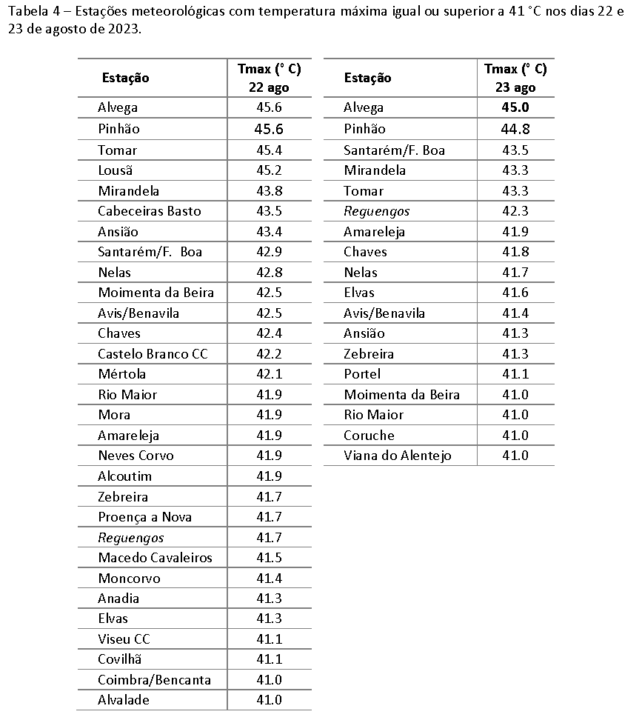The historical maximum temperatures were exceeded on the 22nd of August at seven meteorological stations, located in the center and especially in the north of the country, announced the Portuguese Institute of the Sea and the Atmosphere (IPMA).
They were Tomar, which reached 45,5ºC (a value not recorded since 1997), Cabeceiras de Basto (43,5ºC, since 2000), Nelas (42,8ºC, 1961), Viseu (41,1ºC, 1992), Trancoso ( 40,1ºC, 2000), Luzim (39,8ºC, 1982) and Montalegre (37,5ºC, 1941).
According to the IPMA, “the values of 37.5 °C in Montalegre and 42.8 °C in Nelas are more representative, stations with series of 82 and 62 years, respectively”, that is, where such values were not measured in the last 82 and 62 years.

In Guarda, on the same day 22, the value of 25.9 °C of minimum temperature surpassed the previous extreme for the month of August.
On the 23rd, maximum temperatures for the month of August were exceeded in four stations: Viseu, where the minimum was 26,9ºC, Vila Real (25,9ºC), Vinhais (25,5ºC) and even Lamas de Mouro (19,7ºC). All these higher minimum values were recorded in locations in the North of Portugal.

In the South, there were some locations that, on the 22nd and 23rd, exceeded or equaled the maximum temperature of 41ºC. They were, on the 22nd, Mértola (42,1ºC9, Amareleja (41,9ºC), Neves Corvo (41,9ºC), all in Baixo Alentejo, and also a locality in the Algarve, Alcoutim (41,9ºC). in the south it only contains Viana do Alentejo (41ºC).
Preliminary analysis of the data indicates that the 22nd and 23rd of August were, respectively, the 5th and 6th warmest of the last 15 years in mainland Portugal, with average values of the average temperature of 29.35 °C and 28.76 °C, after the four days between the 2nd and 5th of August 2018, in which meteorological conditions were similar to the current ones, but during a longer time interval.

The 22nd and 23rd of August 2023 also had the 5th and 10th highest average maximum temperature and the 8th and 11th highest average minimum temperature, respectively.
In addition, according to the IPMA, the 7th of August was also a very hot day, with the maximum temperature being on average 1°C lower than the 22nd and similar to the 23rd, remaining as the 8th day with highest average value of the maximum temperature in the last 15 years.
On the 22nd, the value of 45.6°C recorded at the Alvega and Pinhão stations is also noteworthy and, on the 23rd, the value of 45.0°C in Alvega and 44.8°C in Pinhão.
According to the IPMA, these very high values of air temperature that occurred in the mainland, even surpassing previous historical maximums in some stations, «were due to the influence of a mass of hot and dry air originating in North Africa , transported in the circulation resulting from an anticyclone located over the Bay of Biscay and a low pressure valley centered in the south of the Iberian Peninsula, being reinforced by an anticyclonic ridge in altitude over the Iberian Peninsula and by the drought situation that the territory of the Continent has been experiencing to cross".

On the 22nd of August:
• Values of maximum air temperature ≥ 40 °C occurred in about 50% of the territory, and above 42 °C in 15% of the territory;
• Values of maximum air temperature ≥ 35 °C occurred in about 80% of the territory;
• Values of maximum air temperature ≥ 30 °C occurred in practically the entire territory (with the exception of 5 stations – Cabo Carvoeiro, S. Pedro Moel, Santa Cruz, Cabo da Roca and Cabo Raso);
• Values of maximum air temperature ≥ 40 °C occurred in about 40% of the territory, and above 42 °C in 6% of the territory;
• Values of maximum air temperature ≥ 35 °C occurred in about 70% of the territory;
• Values of maximum air temperature ≥ 30 °C occurred in almost the entire territory (with the exception of 7 stations – Viana do Castelo, Cabo Carvoeiro, S. Pedro Moel, Santa Cruz, Almada, Cabo da Roca and Cabo Raso).



















Comments